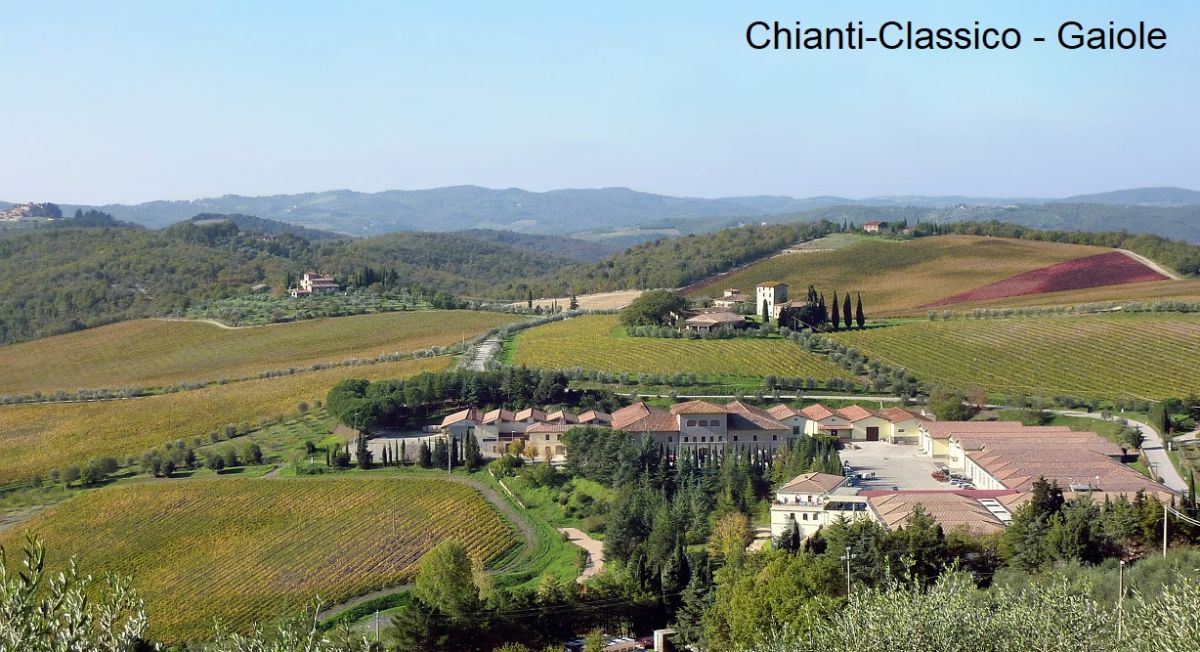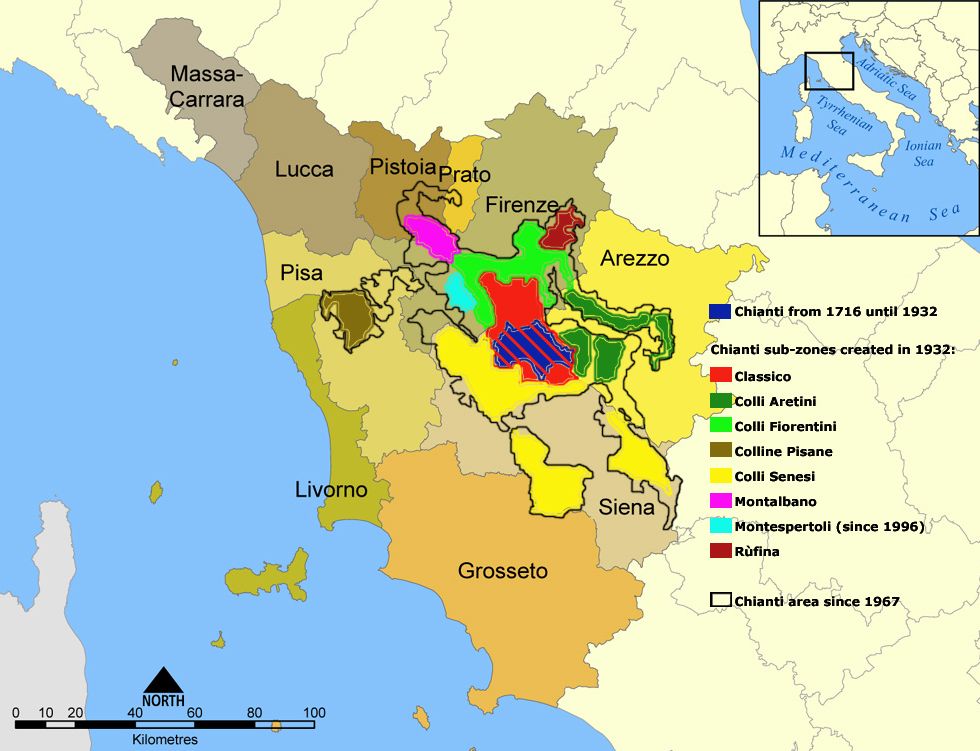Results
2,284 Results
Loading more Results ...
Loading more Results ...
| Chianti DOCG |
Description to Chianti DOCG
DOCG area for red wine in the Tuscany region. The wine is named after the hilly landscape between the cities of Florence and Siena and is probably one of the most famous from Italy. The name is probably derived from the name of an Etruscan family. The first mention of it dates back to 1404, when the famous merchant Francesco Datini (1335-1410) from Prato bought a white wine in Vignamaggio. Originally, Chianti only applied to the areas around Radda, Gaiole and Castellina in the province of Siena in the south of the classic core area of Chianti-Classico. The feudal lords of the Chianti Confederation owned vineyards there as early as the 13th century.

Origin of the borders
There is a legend about the origin of the old borders. The hostile citizens of the city-states of Siena and Florence wanted to put an end to their eternal border disputes and determine the areas of influence through a competition. At the first cockcrow, two horsemen - one from Siena, one from Florence - were to set off.
Where they would meet would be the final border between the two cities. The Sienese had a white cock, which they overfed so that it became fat and lazy and slept for a long time. The Florentines, on the other hand, had a black cock, which they starved so that it began to crow very early. As a result, their rider was able to start much earlier and met his opponent 15 kilometres before Siena at Fonterutoli. This gave Florence a large part of the Chianti region. The emblem of Chianti-Classico is Gallo nero (black cockerel) and is a reminder of this.
Old production rules
A red Chianti was already being produced in the early Middle Ages. However, the grape varieties used have certainly changed and were not so rigorously prescribed at that time or were not followed due to a lack of control and were used very individually. Each winegrower probably produced his Chianti according to the varieties available in his vineyard. According to documentation from 1773, the Chianti of the time consisted largely of Canaiolo Nero with smaller proportions of Sangiovese, Mammolo and Marzemino, i.e. red varieties throughout. However, the white varieties "Tribbiano and San Colombano" (a Trebbiano variety and the Verdea) are also mentioned.
Ricasoli recipe
The legendary Baron Bettino Ricasoli (1809-1880) carried out numerous experiments from 1850 onwards to find an optimal recipe. He summarised the results in a letter from 1872. He recommended Sangiovese as the main grape variety (75%, for flavour and strength) and Canaiolo Nero (15%) for moderation. The white Malvasia del Chianti (Malvasia Bianca Lunga) was suggested as an addition for wines that can be enjoyed young, but was expressly advised against for wines that can be stored for longer. The white Trebbiano Toscano was not included in his recipe, but was only added later (up to 10%). Other varieties (up to 5%) were also permitted.
However, until the end of the 19th century, many winegrowers continued to use the old recipe with a high proportion of Canaiolo Nero. The recommendations proposed by Ricasoli were slow to catch on among tradition-conscious wineries. In the middle of the 20th century, Chianti finally became a mass-produced wine bottled in the typical raffia-wrapped Fiasco bottles and exported in large quantities.
Expansion of the area
The Chianti vineyards have expanded enormously in all directions. This took place to the north as far as Greve and San Casciano, to the east through the Florentine mountains to Arezzo, to the south far beyond Siena and to the west as far as Pisa, very close to the Tyrrhenian coast. The Grand Duchy of Tuscany under Cosimo III (1642-1723) of the Medici dynasty defined one of the first protected designations of origin for wine-growing regions as early as 1716. This concerned Carmignano, Chianti, Pomino and Val d'Arno di Sopra. The boundaries were defined by decree and it was forbidden for wines from other areas to be named as such.
This seems obvious today, but at the time it was a ground-breaking innovation. Today's Chianti area, which has continued to grow in the meantime, is not a closed area, but overlaps with many other DOC zones, and Chianti may also be produced in other DOC zones. These are Carmignano, Montalcino, Montepulciano, Pomino, Val d'Arbia, Valdichiana Toscana and Vernaccia di San Gimignano.

Today's Chianti area
The entire Chianti area (Chianti and Chianti-Classico) comprises vineyards in the six provinces of Arezzo, Florence, Pisa, Pistoia, Prato and Siena with around 7,000 producers in over 100 municipalities. The total area under vines is around 24,000 hectares, of which 7,000 hectares are for the Chianti Classico area, which is considered to be of the highest quality.
In addition, there is a narrower designation of origin within the area with seven subzones that may be mentioned by name on the bottle label. These are Chianti Colli Aretini around Arezzo, Chianti Colli Fiorentini around Florence, Chianti Colline Pisane around Pisa, Chianti Colli Senesi around Siena, Chianti Montalbano around Carmignano, Chianti Montespertoli (since 1997) and Chianti Rufina around Pontassieve. Rufina, Colli Senesi and Colli Fiorentini are considered the best. All other wines from the peripheral areas are simply referred to as Chianti.
1967 DOC and 1984 DOCG classification
Both areas received the DOC classification in 1967 and the DOCG classification in 1984. The DOC classification still provided for the original Ricasoli recipe, in which up to 30% white varieties were permitted. The extremely high yield of 80 hectolitres per hectare and the minimum extract content were also still very generous. However, the DOCG status was then associated with major changes. The white varieties Trebbiano Toscano and Malvasia del Chianti were no longer mandatory, but were alternatively limited to a maximum of 10% for Chianti and 6% for Chianti Classico.
The yield was greatly reduced and the minimum age of the vines for DOCG Chiantis was set at a minimum of five years. This resulted in significant improvements in quality, which had a particularly positive effect on the ageing potential and longevity of the wines. In addition, up to 10% other red grape varieties were permitted, namely Cabernet Sauvignon, Merlot and Syrah. Barrique ageing was also permitted, although this was still mostly carried out in much larger barrels (up to 100 hectolitres). This changed the tart style of the rather light red Chianti into a dark, tannin-rich and storable red wine, which is one of the best in Italy from top producers.
Changes to the regulations in 1996
A change was made in 1996 with amended regulations for Chianti and Chianti Classico. For Chianti, the regulations differ per subzone in terms of yield per hectare, alcohol content and acidity. In principle, marketing may take place on 1 March of the year following the harvest at the earliest. The grape variety mix is at least 75 to 100% Sangiovese, a maximum of 10% Canaiolo Nero, a maximum of 10% other authorised red grape varieties and a maximum of 10% the white varieties Trebbiano Toscano and/or Malvasia del Chianti (Malvasia Bianca Lunga). The maximum yield is 9,000 kg per hectare for normal Chianti and 8,000 kg per hectare for the seven subzones.
The maximum residual sugar content is 4 g/litre. The minimum alcohol content for Chianti and the Colli Aretini, Colli Senesi, Colline Pisane and Montalbano subzones is 11.5% vol.; for the Colli Fiorentini, Rufina and Montespertoli subzones and the Superiore, it is 12% vol. For the Riserva, 12% vol. also applies, as well as 12.5% vol. for six subzones except Montespertoli. The Riserva must mature for at least 2 years, including at least 3 months in the bottle.
Chianti and Chianti Classico
Around 100 million litres of wine are produced annually in the entire Chianti region, a quarter of which is Chianti-Classico. The technique of governo, which was once common, is hardly used any more. The DOC designations Colli dell'Etruria Centrale and Vin Santo del Chianti were created to allow other DOC wines to be produced.
Chianti-Gaiole: Chianti-Chaolo by Adbar - Own work, CC BY-SA 3.0, Link
Map: By User:Kattivik - My own work on Provinces of Tuscany, CC BY 2.5, Link
Recent wines 209
 Badia a Coltibuono - La Badia srl
— Tuscany
2022 Chianti DOCG "Cetamura"
11.00 €
Badia a Coltibuono - La Badia srl
— Tuscany
2022 Chianti DOCG "Cetamura"
11.00 €

 Badia a Coltibuono - La Badia srl
— Tuscany
2021 Chianti DOCG "Cetamura"
10.00 €
Badia a Coltibuono - La Badia srl
— Tuscany
2021 Chianti DOCG "Cetamura"
10.00 €

 Montaioncino
— Tuscany
2018 Chianti DOCG Riserva
85 WP
very good
Montaioncino
— Tuscany
2018 Chianti DOCG Riserva
85 WP
very good

The most important grape varieties
More information in the magazine
- Italy: Empty cellars, small quantities, higher prices High harvest losses and expensive raw materials cause wine prices to rise significantly
- BEST OF Chianti The last of their kind
- BEST OF Chianti Classico Classics in transition
- Castello di Meleto Chianti Riserva Classico 2007, Tuscany, Italy
- BEST OF Chianti Classico A classic with many faces
- Chianti & Classico Bitter hope for a new flowering
- Chianti The non-appellation
- Rùfina - The Tuscany rough north Part 2: In the shadow of the Chianti Classico
- Chianti Colli Fiorentini The search for the typical Chianti
- Wine control Chianti and the DOCG
